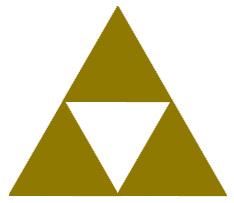How many shapes would you use to replicate the picture of the classic game reference above? Four? Six? Think again. One square makes up the background. One triangle creates the yellow image. And one small upside-down triangle completes the composition.
This little puzzle is just one exercise that Acey Boyce used to demonstrate how games can be used to teach certain concepts. As a graduate research assistant in computer science, Boyce’s studies in educational games represent some of the ways that computer scientists are pushing capabilities of games as part of a growing field called gamification — the use of game elements in non-gaming contexts to guide behavior.
Examples of this include leaderboards and medals in forums and special titles awarded to frequent users of iPhone applications. However, Boyce is particularly interested in using gaming concepts to create new and exciting games that teach players practical skills as they progress through the game.
The games Boyce is interested in differ from the typical educational computer games many students are familiar with — games such as the JumpStart series, Mathblasters and Number Munchers.
“Those games were fun and you remember them fondly, not for the learning but because of the minigames that revolved around the learning,” Boyce said. “You would be playing a game, and then you’d be asked a math question. You’d answer the math question and then get back to your game. It was awesome because there was a game involved but it was no different than sitting down and playing a game of monopoly and then stopping and saying, ‘You can’t go any further until you answer this multiple choice question.’”
Instead of operating in the manner of these older educational games, Boyce said that he wants to completely integrate the learning and the gameplay elements in his games so that the only way players can get better at the game is to get better at a skill such as math or programming.
While teaching at a summer camp, Boyce created a puzzle game to help teach his students. As a computer game that challenged students to try to create several images using the least number of shapes as possible, the triangle puzzle was just one image the game featured.
The game also allowed players to create their own puzzles to challenge their peers. Complete with a point system and a leaderboard, Boyce found that the games were popular among many of the campers and many of them chose to devote their free time to solve the most complex of puzzles.
And to top it off, Boyce could show that the students were learning.
For example, while students worked to solve the puzzles the game presented, they learned basic computer programming concepts.
“[The triangle] puzzle basically teaches the computer science concept of layering or ‘The Painter’s Algorithm,’” Boyce said. “Basically if you’re going to be drawing a picture on a screen or a canvas even, it is computationally less expensive to start with the background. It also teaches players about optimization, to cut out moves that just aren’t present in the final solution.”
With this data supporting the idea that his games are good learning tools, Boyce said he is excited to tap into the potential for education that gaming holds.
“What I would love to see is homework assignments becoming gameplay,” Boyce said. “I don’t know if we can ever get to the point, and I’m not sure if we ever want to get to the point, where we completely remove the teacher from the equation. But assignments where you’re doing problems on a sheet of paper to master concepts are barbaric and outdated and we have so much better ways to teach. I want students to play games for homework, but even more than that, I want students to play them for fun but learn while they are playing.”
Boyce said that he wasn’t always this excited about educational games. Instead, like many other students who dream of creating video games, he wanted to try to get into the video game industry as fast as possible.
“I was originally thinking about going to UNC Charlotte for two years,” Boyce said. “I planned to go in, get out and get into the game industry. Call it a day. I had no interest in research. Zero. I just wanted to make games. However, there came I time that I was doing an outreach [program] for [UNC Charlotte] and we had a problem. My advisor asked how we can improve it and I said, ‘We can make a game.’ So, I made a game.”
However, when he presented the game that he had developed to a group of middle school students, Boyce said he was shocked to see how receptive his students were to his educational game. Boyce said he knew his game could be fun, but he was completely unprepared when two students came up to him after playing with his game with one request — to get a copy of the game so that they could play over their winter break.
“Students were asking for my educational game and I had data to show that they were learning from it,” Boyce said. “It was such an amazing feeling ….That’s when I knew I wanted to go into research. It was because I knew that I could make a difference.”








